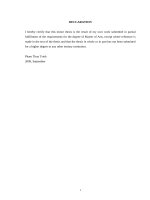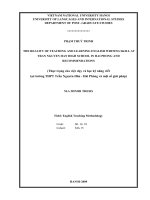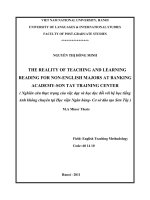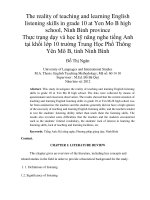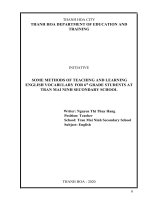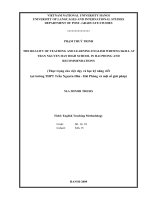The reality of teaching and learning English listening skills in grade 10 at Yen Mo B high school, Ninh Binh province
Bạn đang xem bản rút gọn của tài liệu. Xem và tải ngay bản đầy đủ của tài liệu tại đây (322.2 KB, 9 trang )
The reality of teaching and learning English
listening skills in grade 10 at Yen Mo B high
school, Ninh Binh province
Thực trạng dạy và học kỹ năng nghe tiếng Anh
tại khối lớp 10 trường Trung Học Phổ Thông
Yên Mô B, tỉnh Ninh Bình
Đỗ Thị Ngân
University of Languages and International Studies
M.A. Thesis. English Teaching Methodology; Mã số: 60 14 10
Supervisor : M.Ed. Đỗ Bá Quý
Năm bảo vệ: 2012
Abstract. This study investigates the reality of teaching and learning English listening
skills in grade 10 at Yen Mo B high school. The data were collected by means of
questionnaire and classroom observation. The results showed that the current situation of
teaching and learning English listening skills in grade 10 at Yen Mo B high school was
far from satisfaction: the teachers and the students generally did not have a high opinion
of the necessity of teaching and learning English listening skills; and the teachers tended
to test the students’ listening ability rather than teach them the listening skills. The
results also revealed some difficulties that the teachers and the students encountered
such as the students’ limited vocabulary, the students’ lack of interest in learning the
listening skills, lack of teaching and learning facilities, etc.
Keywords. Tiếng Anh; Kỹ năng nghe; Phương pháp giảng dạy; Ninh Bình
Content.
CHAPTER 1: LITERATURE REVIEW
This chapter gives an overview of the literature, including key concepts and
related studies in the field in order to provide a theoretical background for the study.
1. 1. Definitions of listening
1.2. Significance of listening
1.3. Listening process
1.4. Micro-skills of listening
1.5. Effective teaching of listening
1.6. Stages of a listening lesson
1.6.1. Pre-listening stage
1.6.2. While-listening stage
1.6.3. Post-listening stage
1.7. Potential problems in listening
1.8. Related studies on listening
1.9. Summary
CHAPTER 2: RESEARCH METHODOLOGY
This chapter presents the context and the methodology of the study which are
very important to the realization of the study.
2.1. Overview of the current situation of teaching and learning English at YMBHS.
2.1.1. The school context
YMBHS, which was founded forty years ago, is located at a mountainous area of
Yen Mo District, Ninh Binh province. The school has 33 classrooms, a small library,
and two computer-equipped rooms.
There are 1402 students, most of whom are at low level of proficiency and learn
English because it is a compulsory subject.
Concerning the teaching staff, there are nine teachers of English. All the teachers
majored in English at university. In general, they are enthusiastic and supportive to their
students and to one another.
2.1.2. The new textbook English 10 (the standard textbook) and its listening section
The new textbook English 10 (the standard textbook)
The textbook consists of 16 units and 6 review units. Each unit covers one topic
which is updated and relevant to many aspects of the daily life. Each unit in the textbook
is divided into five sections: reading, speaking, listening, writing, and language focus
respectively.
The listening section in the new textbook English 10
The listening section is the third section in each unit. The aim of this section is to
help the students improve their listening skills such as intensive listening, extensive
listening, listening for specific information, listening for gist. Each listening section is
structured into three stages: Before you listen, While you listen and After you listen.
2.2. Methodology
2.2.1. Research questions
2.2.2. Participants
The participants in the study included 8 teachers of English and 128 tenth graders
at YMBHS in Ninh Binh province.
2.2.3. Data collection instruments
2.2.3.1. Survey questionnaire
Survey questionnaire for the students
The purpose of the questionnaire for the students was to investigate:
- the current situation of learning English listening skills in grade 10 at YMBHS;
- the students’ difficulties in learning English listening skills; and
- their suggested solutions to improve the current situation of teaching and learning
English listening skills.
Survey questionnaire for the teachers
The first part was to get personal information including the teachers’ gender, age
and years of teaching English. The second part that consisted of 9 questions was about:
- the current situation of teaching English listening skills in grade 10 at YMBHS;
- the teachers’ difficulties in teaching English listening lessons; and
- their suggested solutions to improve the current situation of teaching and learning
English listening skills.
2.2.3.2. Classroom observation
The purpose of classroom observations in the context of the present study was
aimed at discovering how the teachers and students actually taught and learnt English
listening skills in the classroom. This helped the researcher double-check the validity
and reliability of the data that were collected through the questionnaires and also gain
more information concerning the research questions.
2.2.4. Data collection procedure
All the participants were informed in Vietnamese about the purposes, methods
and requirements of the collection of the data to make sure they were clear about what
they would have to do and were willing to participate in the study.
The classroom observation was also implemented in four random classes for a
month, both before and after the delivery of the questionnaires.
2.2.5. Data analysis procedure
The quantitative data were converted into percentages and presented in the form
of tables while the qualitative data collected from open-ended questions and
observations were presented by quoting relevant responses. Then the data were analyzed
both descriptively and interpretively.
2.3. Summary
CHAPTER 3: DATA ANALYSIS AND DISCUSSION
This chapter focuses on analyzing the results obtained from the questionnaires
and classroom observations. A detailed discussion of the findings is also presented in
this chapter.
3.1. Findings from questionnaires for the teachers and the students
3.1.1. The teachers’ and the students’ perceptions of the importance of listening in
language teaching and learning at school
3.1.2. The teachers’ and students’ opinions about the students’ listening competence
3.1.3. The teachers’ and the students’ opinions about the listening sections of the
textbook English 10
3.1.4. The teachers’ and the students’ ways of teaching and learning English listening
skills
3.1.4.1. Teachers’ ways of teaching English listening skills
3.1.4.1.1. The teachers’ preparation before listening lessons
3.1.4.1.2. The audiovisual support that the teachers use in listening lessons
3.1.4.1.3. The teachers’ classroom practices in listening lessons
- The teachers’ classroom practices in the pre-listening stage
- The teachers’ classroom practices in the while-listening stage
- The teachers’ classroom practices in the post-listening stage
3.1.4.1.4. The factors affecting the teachers’ ways of teaching in listening lessons
3.1.4.2. The students’ ways of learning English listening skills
3.1.4.2.1. The students’ evaluation of the teachers’ ways of teaching English listening
skills
3.1.4.2.2. The students’ preparation before listening lessons
3.1.4.2.3. The students’ favorite practices in listening lessons
- The students’ favorite practices in the pre-listening stage
- The students’ favorite practices in the while-listening stage
- The students’ favorite practices in the post-listening stage
3.1.4.2.4. The students’ home practice on English listening skills
3.1.5. Difficulties in teaching and learning English listening skills perceived by the
teachers and the students
- Difficulties as perceived by the teachers
- Difficulties as perceived by the students
3.1.6. The teachers’ and the students’ suggested solutions to improve the current
situation of teaching and learning English listening skills
3.2. Findings from classroom observations
In general, all the observed teachers followed similar procedures. The lessons
started with some homework-checking activities, and continued with the stages of a
listening lesson. The common procedures went on with teachers’ presenting new words
and structures, introducing tasks and tasks’ requirements, playing the recordings or
reading the listening text twice or three times, then checking and correcting students’
answers. The lessons ended either abruptly because of the time shortage or with some
question-answering activities.
The classroom observations also showed that both the teachers and the students
did not make careful preparation before the listening lesson.
In the researcher’s observations, the students seemed to listen ineffectively
because they could not get the answers to many comprehensions questions, especially
the ones requiring long responses. Moreover, many students seemed to be uninterested
in the listening lessons.
The lessons were somehow student-centered in the sense that some teachers did
encourage the students’ participation by asking them to read aloud the answers and
engaging them in pair/group work. However, the teachers still played the main role, and
students’ speaking was limited to responses to teacher-directed questions.
3.3. Discussion of the findings
This study aims to investigate the real situation of teaching and learning English
listening skills in grade 10 at YMBHS, Ninh Binh province. Based on the findings and
analysis in the previous parts, this discussion focuses on answering the three questions
proposed in the methodology chapter.
References.
1. Anderson, A. & Lynch, T. (1988), Listening, Oxford University Press, Oxford.
2. Buck, G. (2001), Assessing listening, Oxford University Press, Oxford.
3. Fantahun, H. (2003), An investigation of classroom listening comprehension teaching
practices in relation to the new English coursebooks: Grade 11 in focus, M. A
Thesis, Addis Ababa University.
4. Fraenkel, J. R. & Wallen, N. E. (2005), How to design and evaluate research in
education, (6
th
ed.), McGraw-Hill, Boston.
5. Guo, N. & Wills, R. (2006), An investigation of factors influencing English listening
comprehension and possible measures for improvement, Retrieved on 10
th
March,
2010 from www.aare.edu.au/05pap/guo05088.pdf
6. Hanh, L. T. H. (2010), Developing compensation strategies in listening for 10
th
form
students at Nguyen Van Cu Upper-Secondary School, Gialam, Hanoi,
Unpublished M. A Thesis, ULIS, VNU.
7. Hoa, T. T. T. (2010), An investigation into listening comprehension problems of the
second year English students at Nghe An Junior Teachers Training College,
Unpublished M. A Thesis, ULIS, VNU.
8. Lan, T. T. (2006), Techniques for improving listening skills for gifted students at
Foreign Language Specializing School – College of Foreign Languages –
Vietnam National University, Hanoi, Unpublished M.A Thesis, ULIS, VNU.
9. Nunan, D. (1998), Approaches to teaching listening in language classroom, In
proceedings of the 1997 Korea TESOL Conference, Taejon, KOTESOL, Korea.
10. Palmer, C. (1993), “Innovations and the experienced teacher”, ELT Journal, 47(2),
pp. 166-171.
11. Richards, J. C. (1985), The context of language teaching, Cambridge University
Press, Cambridge.
12. Richards, J. C. (2003), “Current trends in teaching listening and speaking”, The
Language Teacher, 27 (7), pp. 3-6.
13. Richards, J.C. (2008), Teaching Listening and Speaking: from theory to practice,
Cambridge University Press, New York.
14. Rixon, S. (1986), Developing listening skills, Macmillan Publishers Ltd., London.
15. Ronald, K. & Roskelly, H. (1985), Listening as an act of composing, Paper presented
at the 36
th
Conference on College Composition and Communication, [ED 257
094].
16. Rost, M. (1990), Listening in language learning, Longman, London.
17. Rost, M. (1994), Listening, Longman, London.
18. Sheerin, S. (1987), “Listening Comprehension: Teaching or testing”, ELT Journal,
41(2), pp. 126-31.
19. Thu, P. T. H. (2008), Listening difficulties perceived by teachers and students in
using the new textbook for grade 10 at Que Vo II Upper-Secondary School in Bac
Ninh, Unpublished M. A Thesis, ULIS, VNU.
20. Trang, M. T. T. (2010), Reality of teaching and learning listening skills to first-year
non-major students at Phuong Dong University: Problems and solutions,
Unpublished M. A Thesis, ULIS, VNU.
21. Underwood, M. (1989), Teaching Listening, Longman, London.
22. Ur, P. (1996), A Course in Language Teaching, Cambridge University Press,
Cambridge.
23. Van, H. V., Hoa, H. T. X., Loc, D. N., Loi, V. T., Minh, D. T., & Tuan, N. Q.
(2006), English 10, Teacher’s book, Education Publishing House, Hanoi.
24. Wallace, T., Stariha, W.E. & Walberg, H.J. (2004), Teaching speaking, listening and
writing, Retrieved on 10
th
March, 2010 from
25. Yagang, F. (1993), Listening: problems and solutions, English Teaching Forum, 31 (1).

